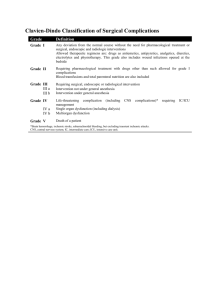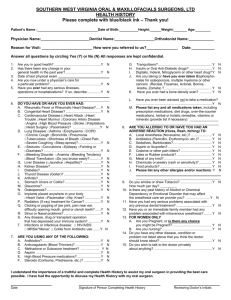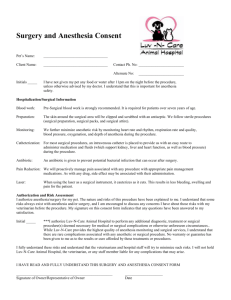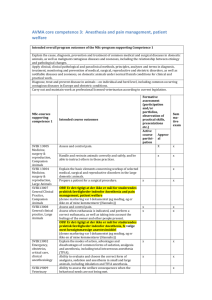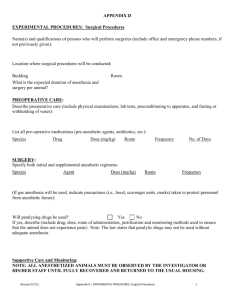Certificate Program in surgical technology
advertisement
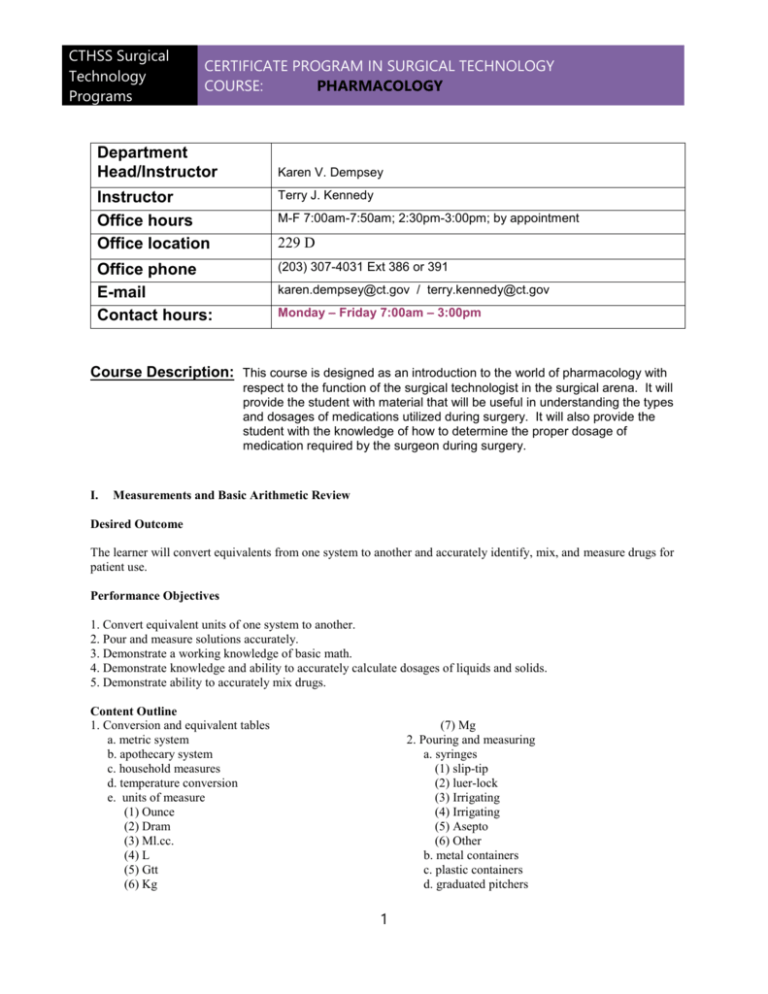
CTHSS Surgical Technology Programs CERTIFICATE PROGRAM IN SURGICAL TECHNOLOGY COURSE: PHARMACOLOGY Department Head/Instructor Karen V. Dempsey Instructor Office hours Office location Terry J. Kennedy Office phone E-mail Contact hours: (203) 307-4031 Ext 386 or 391 M-F 7:00am-7:50am; 2:30pm-3:00pm; by appointment 229 D karen.dempsey@ct.gov / terry.kennedy@ct.gov Monday – Friday 7:00am – 3:00pm Course Description: This course is designed as an introduction to the world of pharmacology with respect to the function of the surgical technologist in the surgical arena. It will provide the student with material that will be useful in understanding the types and dosages of medications utilized during surgery. It will also provide the student with the knowledge of how to determine the proper dosage of medication required by the surgeon during surgery. I. Measurements and Basic Arithmetic Review Desired Outcome The learner will convert equivalents from one system to another and accurately identify, mix, and measure drugs for patient use. Performance Objectives 1. Convert equivalent units of one system to another. 2. Pour and measure solutions accurately. 3. Demonstrate a working knowledge of basic math. 4. Demonstrate knowledge and ability to accurately calculate dosages of liquids and solids. 5. Demonstrate ability to accurately mix drugs. Content Outline 1. Conversion and equivalent tables a. metric system b. apothecary system c. household measures d. temperature conversion e. units of measure (1) Ounce (2) Dram (3) Ml.cc. (4) L (5) Gtt (6) Kg (7) Mg 2. Pouring and measuring a. syringes (1) slip-tip (2) luer-lock (3) Irrigating (4) Irrigating (5) Asepto (6) Other b. metal containers c. plastic containers d. graduated pitchers 1 CTHSS Surgical Technology Programs CERTIFICATE PROGRAM IN SURGICAL TECHNOLOGY COURSE: PHARMACOLOGY 3. Basic mathematics a. fractions b. decimals c. ratios d. proportions e. roman numerals f. percentages II. 4. Dosage calculations a. calculating unit per milliliter dosages b. calculating amount/dosage delivered 5. Mixing medications a. combining medications b. reconstituting medications c. diluting medications Terminology Desired Outcome The learner will define general terminology associated with drug use. Performance Objectives 1. Define general terminology regarding drug purposes and actions. 2. Identify common abbreviations associated with drug use. 3. Identify the most common symbols associated with drug use. Content Outline 1. General definitions a. pharmacology b. pharmacokinetics (1) Absorption (2) Distribution (3) Biotransformation (4) Excretion c. pharmacodynamics (1) Onset (2) Peak effect (3) Duration of action (4) Indication (5) Contraindication 2. Types of medications/effects a. actions (1) Synergist (2) Agonist (3) Antagonist (4) Additive b. effects (1) Relaxation (2) Sedation (3) Amnesia (4) Neuroleptic (5) Analgesia (6) Drying secretions (7) Gastric acid reduction (8) Vagal blockade (9) Other 3. Abbreviations a. stat b. IV c. IM d. PO e. os, od, ou f. qid, bid, tid g. PRN h. NPO i. SC III. Care and Handling of Drugs and Solutions Desired Outcome The learner will demonstrate procedures for the care and handling of drugs and solutions. Performance Objectives 1. Discuss care and precautions in identifying drugs and solutions. 2. Demonstrate safe practice in transferring drugs and solutions from the nonsterile to sterile field. 2 CTHSS Surgical Technology Programs CERTIFICATE PROGRAM IN SURGICAL TECHNOLOGY COURSE: PHARMACOLOGY 3. Demonstrate the procedure for identifying a drug or solution on the sterile field. 4. Explain legal ramifications of improper drug/solution handling. 5. Describe the surgical technologist's legal responsibility in the handling of drugs and solutions. Content Outline 1. Medication nomenclature a. Chemical Name b. Generic name c. trade and brand name 2. Medication control classifications a. Controlled substance b. Prescription medications c. Nonprescription medications-over the counter 3. Medication/solution violations a. Narcotic precautions b. Personnel negligence c. Consequences to patient 4. Laws/ policies and procedures a. Hospital policies and procedures b. State laws c. Verbal orders as accepted practice 5. Medication publications a. Physician’s Desk Reference (PDR) b. The National Formulary c. The National Formulary d. Pharmacopedia of the United States of America = the (U.S.P.) e. National code directory f. American Hospital Formulary Service Index – (AHFS) 6. Sources of medications a. Plants b. Animals c. Minerals d. Laboratory synthesis e. Biotechnology 7. Pharmaceutical preparations a. Gas b. Liquid (1) Solution (2) Suspension IV. (3) Emulsion c. Solid d. Semisolid 8. Routes of administration a. IV b. IM c. SC d. PO e. Intrathecal f. Instillation g.Injection h. Topical 9. Medication identification a. Label information b. Trade name c. Generic name d. Concentration e. Amount f. Expiration date g. Directions for reconstitution/dilution h. Storage/handling precautions/warnings i. Route of admission j. Circulator duty/responsibility k. Surgical technologist (STSR) 10. Medication preparation a. nonsterile area (1) Draw up medication into a syringe b. Nonsterile to sterile field transfer (1) Draw up medication into a syringe (2) Accept medication into the sterile field 11. Techniques of identification a. Labeling devices b. Containers on sterile field c. Identifying medication or solution to other team members Drugs Used in Surgery Desired Outcome The learner will identify the principles of drug use in the care of the surgical patient. Performance Objectives 1. Describe the action, uses, and modes of administration of drugs used in the care of the surgical patient. 2. Describe drug side effects and contraindications for use. 3 CTHSS Surgical Technology Programs CERTIFICATE PROGRAM IN SURGICAL TECHNOLOGY COURSE: PHARMACOLOGY Content Outline 1. Classifications of agents a. analgesics b. narcotic antagonists c. analgesic antipyretic agents d. sedative-hypnotic agents e. tranquilizers f. anticonvulsants g. central nervous system stimulants 1. analeptics 2. emetics h. antiemetics and antihistamines i. autonomic agents 1. adrenergics (alpha and beta) 2. adrenergic blockers 3. cholinergics 4. cholinergic blockers j. cardiac medications 1. inotropic agents 2. antiarrhythmics 3. coronary dilators 4. other k. coagulants and hemostatics 1. Mechanical 2. Chemical 3. Thermal l. anticoagulants and fibrinolytics m. IV fluids n. blood replacement 1. whole blood 2. component therapy V. 3. autologous blood 4. non-blood replacements/plasma expanders o. diuretics p. ophthalmic drugs 1. enzymes 2. irrigating solutions 3. miotics 4. mydriatics/cycloplegics 5. antibiotics 6. viscoelastics/lubricants 7. dyes q. gastric drugs 1. H2-receptor blockers 2. other r. obstetrical agents 1. oxytocics 2. RhoGam 3. other s. hormones 1. sex hormones 2. corticosteroids 3. insulin/glucagon 4. protoglandins 5. other t. anti-infective agents u. contrast media v. antineoplastic chemotherapy w. dyes x. irrigation solutions Anesthesia Desired Outcome The learner will explain the principles of anesthesia administration. Performance Objectives 1. Describe factors that influence anesthesia selection for individual patients. 2. List commonly prescribed preoperative medications. 3. Explain the reasons a preoperative medication is given. 4. List and describe various types of anesthesia. 5. Explain different methods by which an anesthetic may be administered. 6. List and describe commonly used anesthetic drugs. 7. Explain the roles of the scrub person and circulator in the administration of anesthesia. 8. Describe the phases of general anesthesia and possible complications of each phase. 9. List the agents used in local, regional, and spinal anesthesia, and describe the action, administration, and possible complications of each agent. 10. Discuss equipment used as adjuncts to anesthesia. 4 CTHSS Surgical Technology Programs CERTIFICATE PROGRAM IN SURGICAL TECHNOLOGY COURSE: PHARMACOLOGY 11. Explain means of monitoring the condition of the patient during anesthesia. 12. List and describe complications of anesthesia. Content Outline 1. Anesthesia selection a. patient factors 1. age 2. general health 3. current medications 4. allergies 5. substance abuse 6. emergency conditions 7. height & weight 8. comorbid conditions 9. patient’s psychological/emotional state b. type and duration of procedure c. surgeon's preference d. patient's preference e. anesthesiologist's/anesthetist's preference f. American Society of Anesthesiologists (ASA) risk classification 2. Preoperative medications a. sedatives-hypnotic agents b. tranquilizers c. analgesics d. anticholinergics e. antacid/H2-receptor blocking agents f. narcotics 3. Drug actions a. relaxation b. neurolepsis c. analgesia d. drying secretions e. gastric acid reduction g. vagal blockade 4. Types of anesthesia a. general/balanced b. regional c. spinal/caudal d. epidural e. neuroleptic analgesia f. local infiltration 1. injection 2. topical g. topical h. cryoanesthesia i. hypnoanesthesia j. acupuncture k. nerve block l. Bier block 5. Methods of administration a. intravenous b. inhalation c. intramuscular d. intrathecal e. epidural f. infiltration g. topical h. other 6. Anesthesia delivery a. delivery devices (1) mask (2) Laryngeal mask airway (3) Endotracheal intubation b. assistive devices (1) Laryngoscope Rigid Flexible (2) McGill Forcep (3) Stylet (4) Oral Airway (5) Nasal airway (6) Nerve stimulator c. other techniques (1) Cryoanesthesia (2) Hypoanesthesia (3) Acupuncture 7. Anesthetic medications a. inhalation agents (1) O2 (2) N2O (3) Fluothane (4) Enthrane (5) Isoflurane (6) Sevoflurane (7) Desflurane b. neuromuscular blocking agents (1) Depolarizing Succinylcholine (2) Non-depolarizing Atracurium Rocuronium Vecuronium Pancuronium c. intravenous anesthetics (1) Induction barbiturates (2) Thiopental Sodium (3) Methohexital sodium (4) Propofol (5) Etomidate d. local anesthetics e. opiates & synthetics 5 CTHSS Surgical Technology Programs CERTIFICATE PROGRAM IN SURGICAL TECHNOLOGY COURSE: PHARMACOLOGY (1) Meperidine (2) Morphine (3) Fentanyl (4) sufentanil (5) Alfentanil (6) Remifentanil f. neuromuscular blocking reversal agents (1) Edrophonium (2) Neostigmine g. antimuscarinics/anticholinergics (1) Atropine (2) Robinul h. antiemetics i. sedative/tranquilizers (1) Diazepam (2) Midazolam j. reversal/antagonist agents (1) Naloxone (2) Flumazenil k. dissociative agents l. neuroleptic agents (1) Droperidol m. local/topical agents (1) Amides Lidocaine Bupivacaine Mepivacaine (2) Esters Cocaine Pontocaine/tetracaine Cetacaine 8. Roles during administration a. hospital policy b. assisting anesthesia personnel 1. general anesthesia 2. spinal/epidural anesthesia 3. regional anesthesia 4. local anesthesia c. dispensing d. monitoring and documenting 9. General anesthesia phases a. induction b. maintenance c. emergence d. recovery 10. Stages of general anesthesia a. Stage 1 b. Stage 2 c. Stage 3 d. Stage 4 11. Adjuncts to anesthesia a. hypothermia/hyperthermia unit b. blood warming devices c. blood pump d. infusion control devices e. double-cuffed pneumatic tourniquet f. warmed air device 12. Monitoring devices, methods, and attachment a. electrocardiogram b. blood pressure devices c. pulmonary artery catheter d. central venous pressure e. temperature monitors 1. probes 2. Foley temperature catheters 3. skin temperature strip f. pulse oximeter g. controlled ventilation h. system for anesthetic and respiratory analysis (SARA) i. stethoscopes and Doppler j. arterial blood gases k. bispectral index monitor (BIS) l. Swan-Ganz line m. arterial line n. intravenous access 1. peripheral 2. central 13. Anesthesia equipment a. anesthesia machine b. vaporizer c. ventilator d. rebreathing apparatus e. scavenging system 14. Positioning a. positioning for general anesthesia induction (1) supine (2). lateral (3) Fowler’s b. positioning for regional c. positioning for local anesthesia 15. Complications of anesthesia a. aspiration b. laryngospasm/bronchospasm c. malignant hyperthermia d. shock e. cardiac dysrhythmias f. cardiac arrest g. allergic reaction h. Sellick’s maneuver 16. Monitoring devices and methods a. EKG b. BP devices c. Bispectral index monitor (BIS) d. Pulmonary artery catheter e. Central venous pressure 6 CTHSS Surgical Technology Programs CERTIFICATE PROGRAM IN SURGICAL TECHNOLOGY COURSE: PHARMACOLOGY f. Temperature monitors (1) Probes (2) Foley temperature catheters (3) Skin temperature strips g. pulse oximeter h. Controlled ventilation i. System for anesthestic and respiratory analysis (SARA) j. Stethoscopes and Doppler k. Arterial blood gases Course Evaluation: Exams, quizzes, lab practicals, research papers Course Grade: The course grade for students in Health Education will be weighted according to the following activities and assignments: Course Grade: The course grade for students in Surgical Technology will be weighted according to the following activities and assignments: See Introduction to Fundamentals for grade setup. Texts for this Course Surgical Technology For the Surgical Technologist 978-1-4180-5168-6 Caruthers Medical Terminology Systems 978-0-8036-2145-9 Gylys/Wedding Right of Revision Statement: The Eli Whitney Technical School, the Surgical Technology Program, Department Head and instructors reserve the right to revise the syllabus at any time. 7

